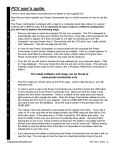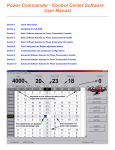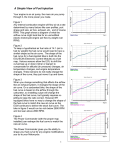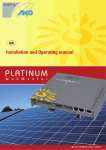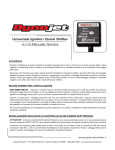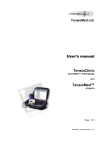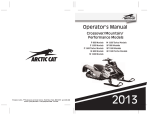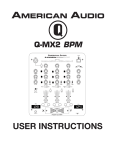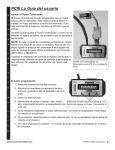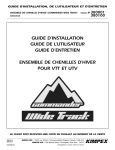Download What oil do you recommend that I run in my sled?
Transcript
Through our many hours talking with customers on the phones and at shows we have noticed that many riders have similar concerns and frequently ask similar questions regarding the Polaris 800 CFI engine. Please read through this entire document, as it contains important information regarding products that we show you have purchased. This information is being relayed to you in an effort to make your snowmobiling experience more enjoyable. We encourage you to contact us with any questions that you may have regarding our products. What oil do you recommend that I run in my sled? Engines that are high horsepower verses cubic centimeter require higher quality oil to support the additional stress on engine parts. This is especially true on EFI engines that run cleaner with an increase in exhaust temperature since fueling is typically leaner when compared to carbureted models. Lower quality oils will tend to run away from heat as well as not having the film strength to support the horsepower range. The 800 CFI engine is very sensitive to oil quality. We recommend running Redline Two Stroke Racing Oil (it has both a snowmobile and a motorcycle pictured on the jug). We have found this oil to be far superior to any other oil that we have tested to date. It has great film strength and lubricity properties and we have not seen a single oil related failure over the last three years with 800 CFI engines running this oil. Redline is not something that we sell; we just get asked this question a lot, and want to let you know what works. For more information on Redline Race Oil, visit their website at www.redlineoil.com under the TWO-STROKE OILS tab on the left. This website also contains a dealer locator. If you choose not to run Redline full synthetic racing oil, we would recommend that you premix 1 ½ ounces of oil per gallon of fuel (approximately 1 pint per tank of fuel) in addition to running your oil injection. This will provide extra oil to the top end and will greatly reduce the risk of having an oil related engine failure. The 800 CFI engine should use at least one quart of oil per tank of fuel. If your sled is not using this quantity of oil, you need to check your oil injection pump setting and adjust it accordingly. What fuel do you recommend I run in my sled? High horsepower engines must have quality fuel of the proper octane to not only promote best performance but also to avoid detonation. Be sure to protect your engine by taking the following precautions. 1 - Always buy fuel from a service station that sells a high quantity of fuel since this will insure that you are getting fresh fuel. Fuel loses octane the longer it is in storage. Keep this in mind in the fall when getting your sled ready for the season. Any fuel from the previous season is no longer good enough to run. Always drain the tank completely and fill with fresh fuel. 2 – We recommend running fuel with a minimum of a 91 octane rating. Try to avoid ethanol fuels. They can be less stable in some conditions and will burn leaner than non ethanol fuel. If there is no choice then always be sure the fuel wires are set for ethanol fuel. 3 – If there is any question of fuel quality, it is a good practice and cheap insurance to add 1 ounce of Lucas octane booster to every gallon of fuel. The Lucas brand octane booster is the one we found to be most reliable and is readily available at most automotive parts stores. 4 – Make sure you understand the ethanol wire that the 800 CFI utilizes and use it properly for the fuel that you are running. How often should I change my fuel filter? We recommend changing your fuel filter once every season or every 1000 miles, whichever comes first. There is quite a bit of garbage that will get into your fuel system that the fuel filter will filter out. If the fuel filter becomes plugged or iced up from sucking some water, it can lean the mixture out and cause the engine to detonate. Should I use any deicer to my fuel? If you are running non-ethanol fuel, it is a good idea to add some isopropyl alcohol (a common brand is Iso-Heet) to your fuel to get rid of the moisture that collects in your tank from condensation. We recommend using 3 ounces per tank of fuel. This will insure that water does not collect in your tank and create problems within your fuel system. If you are using fuel that contains up to 10% ethanol, do not add any fuel system deicer to your fuel. I sometimes see my check engine light flash at me or my sled will go into limp mode. What should I do about it? The 800 CFI is equipped with a detonation sensor to protect the engine against detonation. When it senses detonation the check engine light will flash. If the detonation is not severe, the system is programmed to modify timing and fuel delivery to eliminate the detonation. If the detonation is severe, the system will go into limp mode (also known as latching mode or fail safe mode) and the sled will not run over 6000 RPM. This is a great system to protect your sled against engine damage caused by detonation. We have noticed that detonation will become more prevalent at water temperatures that are above 150 degrees F. The Dragon RMK and Assault do not have a front cooler and also don’t have wheels in the suspension, which causes more drag in trail conditions. If you are trail riding on hard snow or ice, you should switch over to and monitor the water temperature on your gauge. If the water temperature starts to climb up to the 150 degree F mark, we recommend that you drop your ice scratchers to get the temperature to come down. Dragon RMK and Assault models will need their ice scratchers down on most trail conditions. This will also help lubricate and cool the hifax, which will give you longer hifax life. It is normal for your check engine light to flash at you once in a while. However, if it is actively flashing at you, you should unplug your ethanol wires if running in non-ethanol mode. If the light continues to actively flash at you, try adding some Lucas octane booster to your fuel at a mix ratio of 1 ounce to the gallon. If the light continues to be active, you either have very poor fuel quality in your sled or something mechanically or electronically is going wrong with it. You can first try fresh fuel from another station and if that does not eliminate the check engine light from actively flashing at you, you need to get it into the dealer to have it looked at. If your check engine light is actively flashing at you, try riding at a different speed. Vary the throttle position often (pump the throttle a bit as you ride) as this will reduce the chance of detonation. Do I need to run a Power Commander PCIII or PCV fuel control box with my combination? The Power Commander PCIII or PCV fuel controller can be a great performance enhancement for many popular combinations. The PCIII and PCV maps that we have available have been created and tested with the original 2010 update map as well as the new 2010 map that was just released on January 14th , 2010. These fuel maps can be preloaded into a Power Commander PCIII or PCV at the time of purchase from SLP or if you already have a PCIII or PCV, we can e-mail them to you. There is no charge for the maps. SLP Stage 1 kit (SLP lightweight silencer and SLP High Flow air intake kit): The Power Commander is not recommended and SLP has no preprogrammed maps for this combination. SLP Stage 2 kit (SLP single pipe kit and SLP High Flow air intake kit): The Power Commander is recommended but not required for this combination. We have added some fuel in the midrange to give the sled better throttle response with this combination as well as trimming some fuel from the top end to give it better top end performance. With this combination, peak rpm can increase 100 to 150 rpm from the proper fuel mixture at wide open throttle. For customers running at elevations of 0 to 3000 feet, we recommend activating the accelerator pump feature on the Power Commander and setting it as specified by SLP to significantly reduce the midrange hesitation. SLP Stage 3 kit (SLP single pipe kit, SLP High Flow air intake kit, SLP Billet Heads and V-Force 3 reeds): The Power Commander is required for this combination. It provides spot on performance and the fuel needed for the extra compression ratio of our billet heads. Do I need to change my exhaust valve springs? Here at SLP we have found that the exhaust valves on the 800 CFI with the stock Orange springs in them will not open completely at certain elevations. This will result in poor peak performance and low peak rpm. Single pipe combinations: For all elevations 5000 feet and higher, we recommend changing to the Pink exhaust valve springs (SLP part number 14-117). Twin pipe combinations: For all elevations 6000 feet and higher, we recommend changing to the Yellow exhaust valve springs (SLP part number 14-113). What is this I have heard about the thermostat bypass hole being plugged and what does that do? The thermostat has a bypass hole in it that allows a minimal amount of coolant to circulate through the cooling system prior to the thermostat opening. This eliminates hot spots that can arise if the coolant is stagnant in the cylinder and head area. The coolant in the PTO cylinder on the 800 CFI will bypass through the throttle bodies. The coolant in the Mag cylinder on Dragon RMK and Assaults is required to bypass through this small hole in the thermostat plate. We have seen this hole become plugged on some sleds. When that happens, the coolant in the Mag cylinder will develop hot spots prior to the thermostat opening. This can result in engine damage if the machine is operated prior to it warming up to operating temperature. We recommend checking your thermostat to make sure the bypass hole is not plugged. Why does my engine now have less compression with the 2010 Polaris Update and can I safely get the compression back? The Polaris update included a new cylinder head that is designed to be used at all elevations with most types of pump fuel (this is the same head that is used on the 2010 800 CFI). It is a lower compression ratio than the sleds came with in 2008 and 2009. This updated Polaris head leaves room for some performance increases, especially for high elevation riders. We have created a selection of Power Dome™ Heads for the 800 CFI that are a higher compression ratio with a more efficient combustion chamber design. Depending upon the minimum elevation that you are riding will depend upon the compression ratio that you can safely run. SLP can make a recommendation that is right for you. These heads should be used in conjunction with an SLP Single Pipe kit, SLP High Flow intake kit and DynoJet PowerCommander PCIII or PCV fuel controller with SLP’s preprogrammed map and the Polaris 2010 update. V-Force 3 reeds and SLP Powder Valves can also be added to this combination. What spark plugs should I run in my sled? We recommend using NGK BPR9EIX spark plugs in the 800 CFI. These plugs have an exposed tip, fine wire electrode that promotes a better burn. They are less sensitive to fouling and give improved throttle response and peak performance when compared to the stock Champion plugs. What drive clutch belt do you recommend? We recommend the Polaris belt PN 3211115. It is expensive, but very durable. This belt will normally wear out before it blows up or pulls cords. For maximum performance, it is wise to replace this belt about every 500 to 700 miles depending on how hard it is being used. Once it has worn beyond its service limit, your sled will have a difficult time pulling proper peak RPM. This normally happens after about 500 miles of hard mountain riding. You can achieve more mileage out of this belt when trail riding. Riding style and conditions will determine how many miles you can actually get out of the belt before it starts losing performance. If you are down on RPM, the belt is the first thing you should try changing. How many Delrin Washers should I run in my clutch? We recommend only running one delrin washer (SLP PN 50-57) in your TSS-04 stock driven clutch. Place the Delrin washer under the gold colored spring cup. This allows the spring to lock into the cup and the cup will spin on the Delrin washer. Adding a Delrin washer to your clutch reduces the rotational friction providing a more consistent shift pattern. Clutching We have spent a great deal of time in the field testing to provide you with clutching combinations that fit most riding styles. We have recently updated our clutching chart on the 800 CFI to include recommendations for the new Team Tied driven clutch. Please visit our website at www.startinglineproducts.com and type in 09-878 or 09-888 in the product search. Click on the #1 link from the search. This will take you to the product page. Click on the instructions tab and “Download Now”. This is the most current pipe instruction sheet that you are downloading. Pages 6 and 7 have the latest clutching specifications for both RMK and short track models. Cover your sled when pulling it to your riding area. This isn’t a question that we have had, but we often see people driving down the road with their snowmobiles in tow on open trailers without covers on them. This can cause severe effects on your snowmobile and we wanted to caution you about it. In the winter, roads are covered with a filthy mixture of salt, sand and other chemicals that are extremely corrosive and abrasive. Snowmobile air intakes are not air cleaners. The air that the intake is exposed to on the snow is extremely clean and the factories work diligently to eliminate snow ingestion. However, if you tow your sled to the riding area without a cover on it, some of the grit that is on the road (even if the road is dry) will end up in your air intake tract and eventually inside your engine. This mixture of sand, salt and chemicals does horrible things to your engine. The internal parts of your engine will wear much faster if exposed to this. Also, the exterior of your sled takes a beating from this as well. It takes a bit more time to cover your sleds, but the benefit is well worth it. Check your ski alignment and suspension camber. We have seen that some of the most overlooked and neglected areas of your sled are ski alignment and front suspension camber. If either of these areas are out of specification it can cause your sled to handle poorly. Ski Alignment: Ski alignment should be checked at least annually. If you hit something such as a rock, stump or chunk of ice, even if it was just a glancing blow that did no visible damage, you should check your ski alignment. We recommend setting your ski alignment to 1/8” of toe out. For adjustment instructions, refer to your owner’s manual. Camber Adjustment: Camber should be one of the first items that you have checked and set when you purchase a Polaris IQ (new or used). We have seen that some new units are not adjusted properly from the factory. As with ski alignment, if your sled has hit something, even if it was just a glancing blow with no visible damage, you should check and reset your camber adjustment. For adjustment instructions and specifications, refer to Polaris service manual. Intake The stock intake on the IQ chassis does not have the necessary capacity to supply to 800 CFI engine with the air that it requires once an SLP Single Pipe kit has been added. Some intake upgrades are required for maximum performance, especially when riding at high elevation, in deep powder, or in conditions with airborne snow dust. We found three main concerns with the stock intake: the stock air horn is too restrictive, there is not enough available air (intake surface area), and the stock pre-filters and foam restrict air flow. The SLP High Flow™ Intake Kit upgrades each of these components, and solves these issues. It includes a High Flow™ Air Horn kit that delivers more air to the air box, an Upper Dash Intake Vent to provide more surface area for more available air, and a set of Powder Snow Pre-filters that creates more air flow. When riding in deep powder snow, or when snow dust from the trail is hanging in the air, your intake often becomes plugged. The SLP Powder Valve™ helps to rectify this problem. The Powder Valve™ is normally closed, and your air box will act just like stock until your intake begins to plug. As the vacuum in the air box increases, the Powder Valve™ opens, giving you air when the engine would otherwise be strangulated. This provides much greater consistency when riding in powder snow conditions. Sealing your exhaust We recommend sealing your exhaust joints with Permatex brand Ultra Black silicone (SLP part number 090-24). The most important areas are the pipe to silencer connection point and the silencer to bellypan outlet. If your exhaust system is already installed, the silencer to bellypan outlet can be sealed from the outside. Simply roll the sled onto its side and apply a bead of Ultra Black silicone to the joint between the belly pan rubber grommet and the silencer outlet. The reason this is so important is because when you dive into deep snow, the pressure on the silencer outlet will increase. The exhaust gasses will exit wherever they can and often times if there is not a positive seal between the silencer outlet and the bellypan, the exhaust gasses will follow the silencer outlet back under the hood. In this condition the air intake is normally somewhat restricted and is drawing air through the vent holes and seams in the airbox. If exhaust gasses enter the under hood area, they will be sucked back into the intake and the engine will bog from oxygen deficiency.




